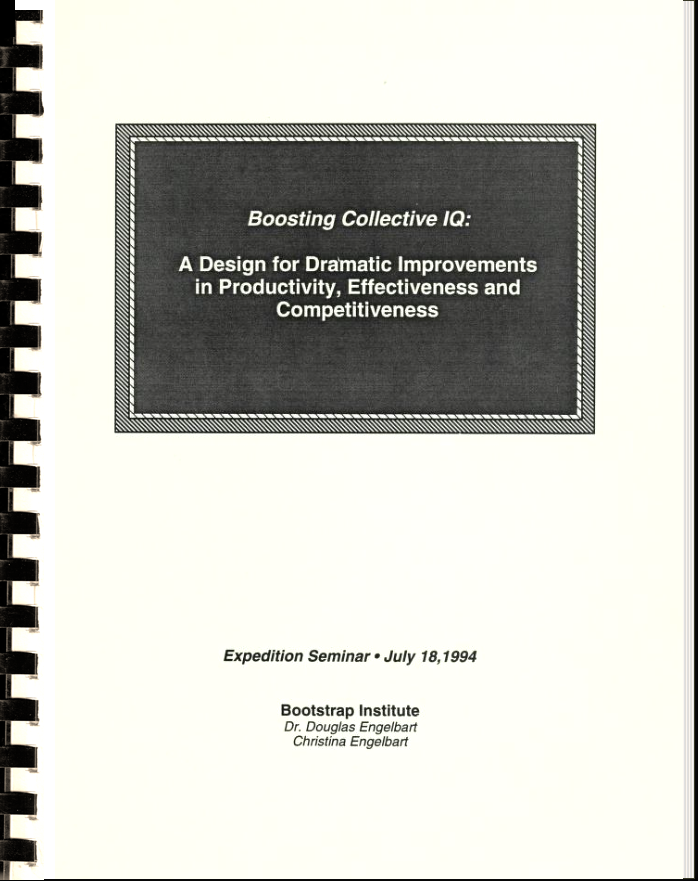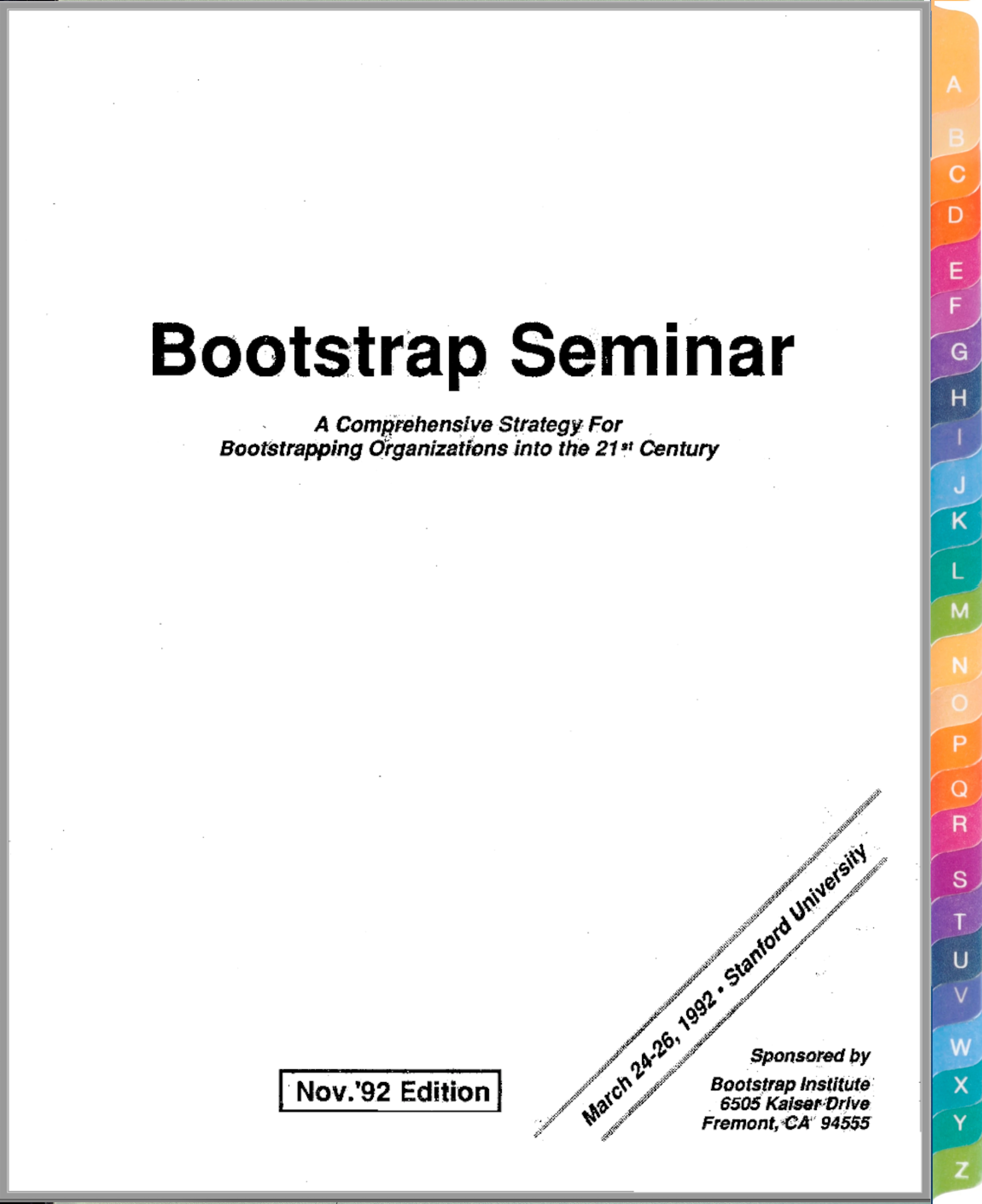Outline offers a bird's eye view; Numbers and Labels show hotlinks you can click to Jump to, or right click to Copy Link to; Numbers show where you are. Learn more.
Books 0By Doug Engelbart1
Boosting Our Collective IQ: A Selection of Readings, Originally produced by Yuri Rubinsky with editing assistance by Christina Engelbart, as a keepsake tribute commemorating the 1995 SoftQuad Web Award presented to Doug at the World Wide Web conference in Boston that December, honoring his early and seminal contribution to the hypertext systems. Of the original print, only 2,000 softcover copies were produced, and 100 Limited Edition hardcover copies were printed, numbered, and signed by Doug Engelbart and Tim Berners-Lee. 1b Includes three of Doug's key papers (edited), Epilogue and details of the Award, 31 pages in all. 1c
The Augmentation Papers: A Collection Since 1960, See Doug's Bibliography for a complete listing of articles included (#2-29), most of which are available online. This item is currently out of print.
Doug's Management Seminar Booklet,
Doug's Management Seminar Binder,
|
|||||||
 Used in university courses 


|
The Coevolution Of Human Potential And Converging Technologies.
Edited by Roco & Montemagno. NY Academy of Sciences, 2004.
Includes paper by Doug Engelbart and James Spohrer:
•
Converging Technologies for Enhancing Human Performance: Science and Business Perspectives. 2003.
2b1
Visualizing Argumentation,
by Kirschner, Shum and Carr (2003)
•
Afterward by Douglas C. Engelbart
2b2
The New Media Reader.
Edited by Noah Wardrip-Fruin and Nick Montfort, The MIT Press, 2003.
Doug Engelbart appears on pages 5, 29, 35, 93-108, 231-246, 290.
Includes two of Engelbart's papers, abridged, with a preface by the Editor(s):
•
Augmenting Human Intellect: A Conceptual Framework. 1962.
•
A Research Center for Augmenting Human Intellect. 1968.
2b3
Global Knowledge Renaissance: Selected Papers from the World Library Summit 2002.
Edited by The National Library Board Singapore. Times Books International, 2003.
ISBN 9812325212
Includes Doug Engelbart's keynote paper:
•
Improving our ability to improve: A call for investment in a new future. 2002.
2b4
Multimedia: From Wagner to Virtual Reality.
Editors: Randall Packer & Ken Jordan. Norton & Company, 2002.
Includes short intro by the editors with abridged version of Engelbart's seminal report:
•
Augmenting human intellect: a conceptual framework. 1962.
2b5
ACM Computing Surveys: Hypertext and Hypermedia.
Volume 31, Number 4es, December 1999
Includes keynote by Doug Engelbart and Jeff Rulifson from
The Unfinished Revolution Symposium,
•
Bootstrapping our collective intelligence. 1998.
[pdf
|eReader]
2b6
Computer Supported Cooperative Work: A Book of Readings,
Irene Greif [Ed.], Morgan Kaufmann Publishers, Inc., San Mateo, CA, 1988, pp. 35-126.
Includes four of Engelbart's papers:
•
A Conceptual Framework for the Augmentation of Man's Intellect. 1963.
•
A Research Center for Augmenting Human Intellect. 1968.
•
Toward High-Performance Knowledge Workers. 1982.
• Authorship Provisions in AUGMENT. 1984.
2b7
Interactive Multimedia: Visions of Multimedia for Developers, Educators & Information Providers,
Sueann Ambron and Kristina Hooper [Ed.], Microsoft Press, 1988, pp. 14-31, this chapter written jointly by Hooper & Engelbart for the book:
•
The Augmentation System Framework. 1988. (AUGMENT,133187,)
2b8
A History of Personal Workstations.
Adele Goldberg [Ed.], ACM Press, New York, 1988, pp. 185-236. This chapter an adaptation of Engelbart's earlier paper Workstation History and The Augmented Knowledge Workshop:
•
The Augmented Knowledge Workshop. 1988.
2b9
DIAC-88: Directions and Implications of Advanced Computing
Nancy Leveson, Douglas Schuler [Ed.], Symposium Proceedings,
Computer Professionals For Social Responsibility, August 21, 1988, pp. 1-17:
• Intellectual Implications of Multi-Access Computer Networks. 1970.
• Coordinated Information Services for a Discipline- or Mission-Oriented Community. 1972.
2b10
Emerging Office Systems - Based on Proceeding of the Stanford University International Symposium on Office Automation,
Robert M. Landau, James H. Bair & Jean H. Siegman, Ablex Publishing Corporation, 1982 & 1984, pp. 134, 287-308:
• Toward Integrated, Evolutionary Office Automation Systems. 1978
• Evolving the Organization of the Future: A Point of View. 1980.
2b11
Vistas In Information Handling: The Augmentation Of Man's Intellect By Machine,
Howerton & Weeks [Editors], Sparton Books, February 1963, pp. 1-29 Chapter 1:
•
A Conceptual Framework for the Augmentation of Man's Intellect. 1963.
2b12
More Featuring Doug
2c
Books featuring Doug Engelbart in one or more chapters.
A Heritage of Innovation: SRI's First Half Century.
Donald Nielson, SRI Vice President Emeritus, 2005.2c1
What the Dormouse Said.
John Markoff. Penguin Books, 2005.
You'll find Doug on pages 4-12, 14-20, 39-58, 75, 89, 103, 118, 144-148, 164, 176-177, 242-245, 276, 286-287.
2c2
Bootstrapping - en strategi för att förbättra förmågan till bättre förmåga : kunskapshantering i en komplex och tidspressad verklighet.
Bengt Göran Wennersten, Teldok'84 Rapport, Tryckeri: Hj Brolina Offset AB, Stockholm, Sweden. 1993.
Perspectives on the Computer Revolution,
Zenon W. Pylyshyn & Liam J. Bannon [Editors], Ablex Publishing Corporation, 1989,
pp. 301-306, Chapter 15:
Portraits of Success: Impressions of Silicon Valley Pioneers.
Carolyn Caddes, Tioga Publishing Company,
1986. Pages 66-67. 2c5
Featuring Doug with select others
2d
"Human-Computer Interaction." Alan Dix, Janet Finlay, Gregory D. Abowd, Russell Beale, Pearson Education Limited, Third Edition 2004, pp. 72, 167-169, 176.2d18
"Cyber_Reader," 43 Contributors, Phaidon Press, Inc., 2002, pp. 60-65. 2d17
"How The Web Was Born: The Story of the World Wide Web." James Gillies & Robert Cailliau, Oxford University Press, 2000, pp. 91, 98-100, 104, 118, 130, 195, 203, 232.2d16
"The Dream Machine: J.C.R. Licklider and the Revolution That Made Computing Personal," M. Mitchell Waldrop. Penguin Books, 2002, pp. 5, 210-217, 241-243, 255, 261, 273, 278, 285, 287-294, 342, 358, 360, 364, 406,, 465, 470.2d15
"Virtual Teams - 2nd Edition," Jessica Lipnack & Jeffrey Stamps, John Wiley & Sons, Inc., 2000, pp. 17-18, 257-258.2d14
"Fire in the valley - The Making of the Personal Computer," (Second Edition) Paul Freiberger and Michael Swaine, McGraw-Hill Publishers, Inc., 2000, pp. 207, 209-210, 303-306,408-409, 437-440, 446.2d13
"Engineering Tomorrow," Trudy E. Bell and Dave Dooling, IEEE Press, 2000, pp. 82-84.2d12
"Weaving the Web," Tim Berners-Lee with Mark Fischetti, Harper Collins Publishers, Inc., 1999, pp. 6, 50.2d11
"Computer Media and Communication,"Edited by Paul A. Mayer, Oxford University Press, 1999, Chapter 4.2d10
"Interface Culture," Steven Johnson, Harper Collins Publishers, 1997, pp. 11, 13-14, 16, 20-22, 24, 26, 38,44, 46, 47, 82, 90, 169, 225.2d9
"Wizards and Their Wonders,"Christopher Morgan/Louis Fabian Bachrach, ACM Press, 1997, pp. 76-77.2d8
"Organizing Genius," Warren Bennis/Patricia Ward Biederman, Addison-Wesley Publishing, 1997, pp.64-65, 67, 171.2d7
"Where Wizards Stay Up Late," Katie Hafner & Matthew Lyon, Simon & Schuster, 1996, pp. 72, 78, 203,263.2d6
"Computer Currents - Navigating Tomorrow's Technology," George Beekman, The Benjamin/Cummings Publishing Company, Inc., 1994, pp. 154-155.2d5
"The Virtual Community," Howard Rheingold, Addison-Wesley Publishing Company, 1993, pp. 52, 65-66, 70, 72-73, 113-114.2d4
"Virtual Reality." Howard Rheingold, Simon & Schuster, 1991, pp. 72-75, 81-88, 98, 101, 105, 133, 180,241-246.2d3
"Portraits of Success, Impressions of Silicon Valley Pioneers," Carolyn Caddes, Tioga Publishing Company, 1986, pp. 66-67.2d2
"En Route to Compatible Computing", Input/Output, Time-Life Books, Inc., 1986.2d1
Mentioning Doug
2e
"Information Systems - A Business Approach," Steve Benson & Craig Standing, John Wiley & Sons Australia, Ltd., 2002, p. 61.2c14
"Information Systems - A Business Approach," Steve Benson & Craig Standing, John Wiley & Sons, 2nd Edition, 2004/2005, p. 67.2c13
"Database Backed Web Sites: The Thinking Person's Guide to Web Publishing," Philip Greenspun, Ziff-Davis Press, 1997, p. 334.2c12
"Working With Objects, The OO ran Software Engineering Method," Trygve Reenskaug, P. Wold & O. A. Lehne, Manning Publications Company, 1996, Dedicated to Doug Engelbart, p. 285.2c11
"Managing the Evolving Corporation," Langdon Morris, Van Nostrand Reinhold, 1995, pp. 123-124 & 130.2c10
"Being Digital," Prof. Nicholas Negroponte, Alfred A. Knopf, Inc., 1995, pp. 69, 130-131.2c9
"Upsizing The Individual In The Downsized Organization," Robert Johansen & Rob Swigart, Addison-Wesley Publishing Company, 1994, p. 165.2c8
"Econoquake!, How to Survive & Prosper in The Coming Global Depression," Barry Howard Minkin, Prentice-Hall, Inc., 1993, pp. 88 and 239.2c7
"Shared Minds, The New Technologies of Collaboration," Michael Schrage, Random House, Inc., 1990, p. 97.2c6
"Information Systems Management In Practice," Barbara McNurlin & Ralph Sprague, Prentice Hall, 2nd Edition, 1989, pp. 208, 378-380.2c5
"Mapping Hypertext," Robert E. Horn, The Lexington Institute, 1989, pp. 6, 254-257.2c4
"Groupware," Robert Johansen, The Free Press, 1988, pp. 2-5, 39.2c3
"Fumbling The Future, How Xerox invented, then ignored the first personal computer," Douglas K. Smith & Robert C. Alexander, William Morrow & Company, 1988, pp. 87-88, 107-109 & 169.2c2
"Office Automation, A User-Driven Method," Don Tapscott, Plenum Press, 1982, pp. 1, 18-19, 41, 70 & 90.2c1
Unauthorized Works
3
"Engelbart Hypothesis," Eileen Clegg & Valerie Landau, 2009, is an unauthorized work [details]. Formerly printed in a limited edition as "Evolving Collective Intelligence". 3a
































